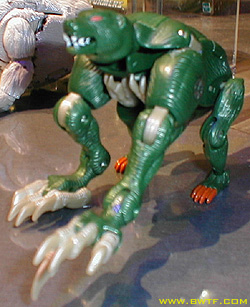 BEAST
WARS: TOY REVIEW
BEAST
WARS: TOY REVIEW
The wolverine's rear limbs are visible from the underside, but are tucked in and textured so well that you would barely notice them if it weren't for the orange claws on the ends. A very minor point (if you want to get technical about dinosaurs) is that the feet have 4 toes instead of 3, but this is clearly a concession to the wolverine mode, which shares these legs. This mode has 17 points of articulation, including the toes and jaw.
The Mutant Beast action feature is contained within this
mode also: flip up the top of the velociraptor's head, and there is the
robot head in silver and black. The tips of the robot head's antennae form
the velociraptor's eyes.
A step not included in the instructions, is that if you flip the front legs outward, swivel the thighs 180º, then also swivel them at the knees (so the the mutant symbol is on the inside of the leg), then you change the texturing on the upper legs from the leathery texture of the velociraptor to the fur of the wolverine.

Length: 120 mm
There are always going to be trade-offs when making toys
of this kind, between the respective modes, and it seems that the majority
of concessions have been made by this mode. The first and most glaring
problem is that this wolverine is GREEN. It would have seemed to
me obvious that a brown velociraptor would have looked far better than
a green wolverine, but clearly the people at Hasbro thought differently.
Secondly is the almost complete lack of highlights other than the orange rear toes and eyes, and white teeth. The fur detailing is nice, but there was plenty of room for SOME brown detailing that wouldn't have shown through on the velociraptor mode. A bit of a lost opportunity here.
I don't want to sound too negative about this mode, and have proabably devoted more space to these negative elements than their impact deserves. These aside, the mode holds together tightly, with the smooth furred contours not being too interrupted by joints or kibble from the other mode. The front feet are massively clawed and fierce looking, matching this diminutive beast's reputation. This mode has 19 points of articulation, including the jaw.
Strangely, Razor Claw does not seem to have any hidden mechanical parts. This seems odd given that this was supposedly one of the key action features of the Mutant Beasts.
Overall though, a fun toy, with its complex and satisfying
transformation being its best feature. Neither mode betrays many features
of the other mode (apart from the colours), but the velociraptor is clearly
the more accurate and displayable mode.
Bibliography: Children's Museum of Indianopolis.
The wolverine is noted for its strength, cunning, voracity and fearlessness.It may follow traplines to cabins and devour foodstocks or carry off portable items. Its offensive odour permeates the invaded cabin. It is a solitary, nocturnal hunter, preying on all manner of game. The wolverine's sole predator is man. Its fur is valued for trimming parkas, as frost and frozen breath can be easily brushed off the smooth hairs. A litter contains one to five young. The gestation period is about nine months.
Bibliography: Encylopaedia
Brittanica